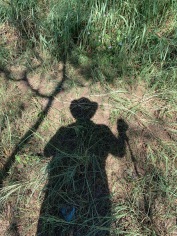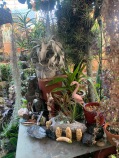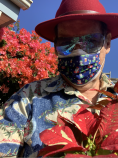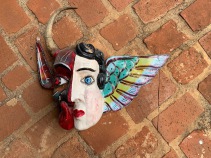"The Correct Application of the Laws of Life"
Life has always been – and it still is – a puzzle that defies decoding
and demystification. ––Yunus A. Çengel
What are the "Laws of Life"?
Arthur Pauls coined the name Ortho-Bionomy from Greek roots and never elucidated what specific laws he had in mind. It was a poetic and allusive coinage.
There are many books and essays published under the title of "Laws of LIfe" and most are opinions about moral behavior. In science, among biologists, there is little agreement as to what life is and what "laws" it is subject to. Life seems to avoid being codified.
For instance, is a virus a living thing or not? Most biologists say no. Yunus Çengal, professor of mechanical engineering, says yes, a virus is a living thing. For what it's worth I agree with Professor Çengal on this point (though I question at least one of his points. I will be referencing his article, "Eighteen Distinctive Characteristics of Life," which can be found online(hyperlinked here).
What is Life?
We know from Gaston Bachellard's phenomenological analysis that Life is round. Of course, it has to be because Life is interiority.
Life is the inside of the world. Deleuze and Guattari write of the "desiring machine" presumably as some aspect of life. I won't try to explain D&G but pause at the comic effect of these two words juxtaposed. The phrase desiring machine seems an oxymoron if one thinks of a machine that is desiring something. Perhaps the machine is to be desired, as "I desire a machine." Or is it saying something like, "A living organism has machine-like qualities but it has this added feature that it desires." Is it lampooning in a subtle way the mechanical view of the universe (William Blake called it "Newton's Sleep)? Regardless, there is desire; whatever one calls the particular arrangement of molecules in a pattern that persists over time, it displays purpose, it is appetitive, which to say it has desire, it hungers. From the simplest organisms to the most complex there is a preference for this over that.
Life is dynamic kinetic stability; a pattern that persists over time by changing.
References
What is life? Erwin Schrodinger. 1944, 2012 edition with an introduction by Roger Penrose.
What is LIfe? J.B.S. Haldane. 1949
What is LIfe?: How Chemistry Becomes Biology. Addy Pross. 2012.
The Poetics of Space. Gaston Bachelard. 1957, reprinted 2014.
Eighteen Distinctive Characteristics of Life. Yunas A. Çengal. 2023.
https://www.ncbi.nlm.nih.gov/pmc/articles/PMC10123176/#:~:text=In%20biology%2C%20it%20is%20generally,be%20responsive%20to%20the%20environment.
Discovering the Laws of Life. John Marks Templeton (forward by Norman Vincent Peale). 1995
Reciprocity as a Law of Life
The Ongoing Action of the Good
“Ortho-Bionomy can’t be taught, it can only be caught.” This was a favorite aphorism of Dr. Pauls. It can be argued that he may have said this merely to defend his own lack of teaching skills. But I can attest to the fact that one of the most important things I learned in the early years of studying under Dr. Pauls was not something that was taught. I had observed that when a person I was working on “let go” of some area of pain or density of tissue (the problem) that letting go in the other was accompanied by some similar letting go in myself. I cannot say who led or who followed but I have learned it does not matter.
I tested this notion out with my very first paid client. A woman I knew casually had been in an automobile incident that left her with a painful whiplash. She had heard I did something that might help and approached me for a ‘session.’ I don’t know what prompted me to approach it as I did except that I did not feel quite up to doing a session as I was experiencing considerable lower back pain. The approach I took was to ready myself to address her neck and then focus on my own back pain, using self-care methods I had been working with (based on Phase Seven).
I did not need to ask her how her neck felt. As soon as we were done she handed me some money, double the amount I had asked for. If this was a tip it was a generous tip; I thought of it rather as her paying for my session as well as her own.
In 1925 a French anthropologist named Marcel Mauss published an important monograph titled “The Gift.”*
Mauss drew attention to the important role of reciprocity in human affairs. This was revolutionary at the time. Since then reciprocity has become a mainstay in the study of ecology. I recently had the opportunity to observe the behaviors of an African Gray parrot kept as a ‘pet’ (put that in scare quotes as one did not dare to actually pet the pesky bird). Mostly I observed how messy and how destructive a creature it was. Most of his food fell to the floor and he kept his mighty beak in shape by shredding all he could of his surrounding: shoes, books, furniture, pretty much anything he was allowed access to. Kept as a pet, the bird was a destructive menace. Respect the beak.
When I imagined the bird in what could have been his natural surround everything he did made perfect ecological sense. I saw that he took no more food than he needed, letting the rest drop to feed others, or to add to the indispensable layer of compost that is most of what jungle soil consists of. He wasn’t wasting the food but sharing it with countless critter-kin of the forest floor. Shredding bits of wood kept his beak in condition and also helped to break down the lignins and cellulose, adding to the compost. And of course, there was his random, constant defecation (pooping on everything). The bird was programmed to practice a necessary reciprocity and his bizarre environment would have none of it. His nature was forced to express itself in a place where nature was exiled.
The word ‘Ortho-Bionomy’ was coined to mean “the correct application of the laws of life.” Pauls never said a word (not in my hearing) about what these laws are that we are to be following and applying. Doing a search of biological literature I soon learned there are no generally agreed-upon laws of life, though there are a number of attempts. Part of the problem here is that Life itself remains free of definition.
In 1943 a famous physicist (those lovers of Laws), Erwin Schrödinger (remember his cat) delivered a lecture series, published later as a book, “What is Life?”* It did little to provide an answer. “...living matter, while not eluding the ‘laws of physics’ as established up to date, is likely to involve ‘other laws of physics’ hitherto unknown, which however, once they have been revealed, will form just as integral a part of science as the former.” Much of the book looks at the seeming paradox of the second law of thermodynamics, explaining why it really is not a paradox, that law of physics remains unbroken (and we need not fear being arrested by the nature police). Despite whatever Schrödinger had to say on the matter there remains no unassailable definition of Life and thus no set of laws of Life.
I can only assume that Pauls’ use of the phrase was intended as poetic. It calls to mind a quote attributed to Werner Erhard, “Ride a horse in the direction it is going.” If I were to try to compile some set of laws of Life I would have to place a Law of Reciprocity near the top. Remove reciprocity and natural (eco)systems degrade, that is to say, there is an increase in disorder. The second law of thermodynamics rules.
I am presently engaged in being trained in a process of lay spiritual care. I was surprised to find the principle of reciprocity embedded in the training. The point of view expressed is that in coming to you seeking help they are offering you a gift. This also returned me to my earlier days in Ortho-Bionomy when I focused on my own ‘problem’ in order to ‘fix’ (forbidden word!) someone else’s. I immediately realized it was a role reversal. The other person, coming to me in need, weak and powerless, is now the healer. It reverberates back and forth, a resonant relationship.
This is the point (I don’t know him to have explained it this way) of the Reflex Pauls named Regret. Touch upon a pain in the Other and while maintaining (soft, soft) contact turn your attention inward to some past regret, feel it, and resolve it. The Other’s pain is likely to vanish with it. Now we know of course that this feeling of regret is a matter of recognizing a shifting pattern of subtle muscular tension throughout the body. By focusing on it we exaggerate it, making it something under our control. Resolving it means letting it go. The Regret Reflex is nothing more than Phase Seven with yourself being the target.
My experience with Ortho-Bionomy is that it is not a zero-sum game—one’s gain is another’s loss. I do not relieve you of your pain by taking it upon myself (play the scapegoat). Rather I offer to find a way in which both can experience a gain. But gain in what? Health, freedom, well-being? Mostly it involves the sense of well-being.
I like to think about the grand migration of the monarch butterfly, that golden beauty with but a fly-speck of a brain (or is it nothing but brain?). It is a journey of thousands of miles, taking multiple generations, a return to the ancestral home: a bit of forest in Mexico. The monarch does not see, smell, or taste its way home. Indeed it ‘knows’ nothing of home. The butterfly simply rides a current of well-being, fully partaking in the essential goodness of life.
Tuning your sense of well-being, while in touch with another’s pain. This is one thing Ortho-Bionomy means to me; this I see as the process of Phase Seven.
*The two books referred to can be found in PDF form:
https://files.libcom.org/files/Mauss%20-%20The%20Gift.pdf
http://strangebeautiful.com/other-texts/schrodinger-what-is-life-mind-matter-auto-sketches.pdf





